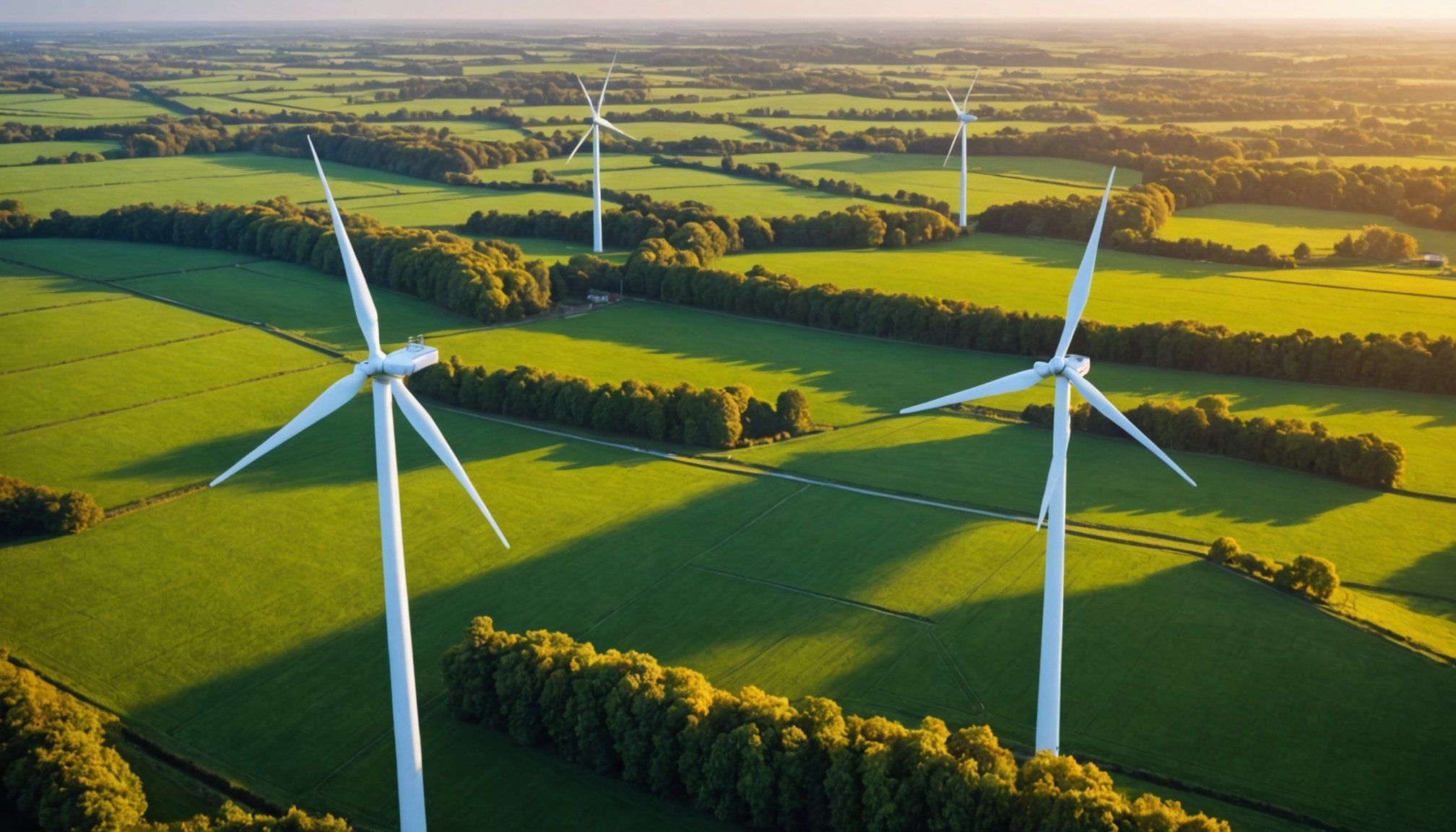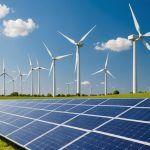Unveiling the Key Trends Transforming the Future of Renewable Energy in the UK
The UK is at the forefront of a revolutionary shift in the energy sector, driven by a compelling need to reduce carbon emissions and achieve a net zero future. Here, we delve into the key trends that are transforming the landscape of renewable energy in Great Britain.
The Rise of Green Hydrogen
Green hydrogen is emerging as a pivotal component in the UK’s energy transition. The British government has recently announced significant funding for green hydrogen projects, marking a major milestone in the country’s journey towards a low-carbon future.
Also read : Essential strategies for uk tech startups to secure seed funding success
Government Funding and Projects
In November 2024, the UK government confirmed the financing of 11 new green hydrogen projects across England, Scotland, and Wales. These projects, selected under the first Hydrogen Allocation Round (HAR1) launched in July 2022, have a combined capacity of 125 MW and are set to be among the world’s first commercial-scale green hydrogen projects. The government has allocated £3.9 billion (approximately $5 billion) for green hydrogen producers and carbon capture, utilization, and storage (CCUS) projects between 2025 and 2026[1].
Industry Initiatives
Companies like RWE are also making substantial strides in this area. RWE has obtained the necessary construction and environmental permits to build a 100 MW electrolyzer in Eemshaven, Netherlands. This electrolyzer will contribute to the integration of the terrestrial energy system associated with the 795 MW OranjeWind offshore wind project in the North Sea, a project RWE is undertaking in collaboration with TotalEnergies[1].
Have you seen this : Unlocking capital: proven techniques for uk healthcare startups to draw in investors
Expanding Wind Energy Capacity
Wind energy, both onshore and offshore, continues to be a cornerstone of the UK’s renewable energy strategy.
Offshore Wind Ambitions
The UK is committed to enhancing its offshore wind capacity, a sector that has seen remarkable growth. The government’s new target to reduce greenhouse gas emissions by 81% by 2035 includes a significant focus on offshore wind development. This ambition is part of the broader vision to achieve net zero carbon emissions by 2050[2].
Onshore Wind Contributions
Onshore wind, though sometimes more contentious due to local opposition, remains a crucial part of the renewable energy mix. Projects like those in Scotland and Wales are contributing to the overall wind energy capacity, helping to reduce the country’s reliance on fossil fuels.
Solar Energy: A Growing but Challenged Sector
Solar energy, while not as dominant in the UK as in sunnier climates, is still an important part of the renewable energy landscape.
Challenges and Opportunities
Despite the UK’s less favorable solar conditions, innovations in solar panel technology and energy efficiency are making solar power more viable. However, the sector faces challenges, particularly in terms of cost competitiveness and policy support. For instance, in Spain, the solar market is struggling due to volatility, leading companies like Endesa to shift their focus towards wind and hydroelectric power[4].
Carbon Capture and Storage (CCS)
CCS technology is critical for reducing emissions from both existing power stations and industrial processes.
Government and Industry Commitment
The UK government has emphasized the importance of CCS in achieving its climate goals. The funding allocated for CCUS projects alongside green hydrogen initiatives underscores this commitment. Companies like RWE are also reducing their CO2 emissions significantly, with a 21% reduction in the first nine months of 2024, partly due to the reduced use of coal and gas and the increased use of renewables[2].
Energy Efficiency and Storage
Energy efficiency and storage are essential for a smooth transition to a renewable energy-dominated power sector.
Innovations in Energy Storage
Advances in battery technology and other energy storage solutions are crucial for stabilizing the grid and ensuring a consistent supply of electricity. The integration of renewable energy sources, which can be intermittent, relies heavily on these storage solutions.
Energy Efficiency Measures
Improving energy efficiency across various sectors, including residential, commercial, and industrial, is vital. Policies aimed at promoting energy-efficient practices, such as the use of electric vehicles and heat pumps, are being implemented to reduce overall energy demand and emissions.
Electric Vehicles and Mobility
The transition to electric vehicles (EVs) is a key aspect of the UK’s low-carbon strategy.
Government Incentives and Industry Developments
The UK government has set ambitious targets for EV adoption, with plans to phase out new petrol and diesel car sales. Companies like Hyundai Motor are innovating in this space, with the recent unveiling of a hydrogen fuel cell electric vehicle (FCEV) concept that boasts an autonomy of over 650 km on a single refueling[1].
Climate Change and Global Implications
The UK’s energy transition is part of a broader global effort to combat climate change.
Global Cooperation and Best Practices
The UK’s strategies and achievements serve as a model for other countries. For instance, TotalEnergies’ global outlook emphasizes the need for deep decarbonization of the electricity grid, increased energy efficiency, and the adoption of clean hydrogen and carbon capture technologies[3].
Practical Insights and Actionable Advice
For individuals and businesses looking to contribute to this transition, here are some practical insights and actionable advice:
Invest in Renewable Energy Sources
- Solar Panels: Even with the UK’s less favorable solar conditions, investing in solar panels can still provide significant energy savings and contribute to the national renewable energy goals.
- Wind Power: Supporting wind energy projects, whether through community schemes or personal investments, can help increase the UK’s wind energy capacity.
Adopt Energy-Efficient Practices
- Energy-Efficient Appliances: Using energy-efficient appliances and lighting can significantly reduce household energy consumption.
- Insulation and Building Standards: Ensuring homes are well-insulated and meet modern building standards can reduce heating needs and energy consumption.
Transition to Electric Vehicles
- Government Incentives: Take advantage of government incentives for purchasing electric vehicles.
- Charging Infrastructure: Support the development of charging infrastructure by advocating for more public charging points.
Detailed Bullet Point List: Key Trends and Initiatives
-
Green Hydrogen Projects:
-
11 new projects funded by the UK government
-
Combined capacity of 125 MW
-
£3.9 billion allocated for green hydrogen and CCUS projects
-
RWE’s 100 MW electrolyzer project in the Netherlands
-
Wind Energy Expansion:
-
Offshore wind targets to support 81% emission reduction by 2035
-
Onshore wind contributions in Scotland and Wales
-
Increased focus on wind energy to achieve net zero by 2050
-
Solar Energy Developments:
-
Innovations in solar panel technology
-
Challenges in cost competitiveness and policy support
-
Shift towards wind and hydroelectric power in some regions
-
Carbon Capture and Storage (CCS):
-
Government funding for CCUS projects
-
Industry commitment to reducing emissions (e.g., RWE’s 21% reduction)
-
Critical role in achieving climate goals
-
Energy Efficiency and Storage:
-
Advances in battery technology
-
Importance of energy storage for grid stability
-
Energy efficiency measures across various sectors
-
Electric Vehicles and Mobility:
-
Government incentives for EV adoption
-
Industry innovations (e.g., Hyundai’s FCEV concept)
-
Phase-out of new petrol and diesel car sales
Comprehensive Table: Renewable Energy Targets and Initiatives
| Initiative | Target | Funding/Investment | Expected Impact |
|---|---|---|---|
| Green Hydrogen Projects | 125 MW capacity | £3.9 billion | Reduce emissions, support low-carbon economy |
| Offshore Wind Expansion | Support 81% emission reduction by 2035 | Ongoing investments | Increase renewable energy capacity, reduce fossil fuel reliance |
| Solar Energy Developments | Innovate in solar panel technology | Various investments | Increase solar energy contribution despite challenges |
| Carbon Capture and Storage (CCS) | Reduce emissions from power stations and industries | Government funding | Achieve climate goals, reduce industrial emissions |
| Energy Efficiency and Storage | Improve energy efficiency, advance storage solutions | Ongoing investments | Stabilize grid, ensure consistent electricity supply |
| Electric Vehicles and Mobility | Phase out new petrol and diesel car sales | Government incentives | Reduce transportation emissions, promote low-carbon mobility |
Quotes from Key Figures
- Rachel Reeves, UK Chancellor: “The funding allocated for green hydrogen and CCUS projects is a significant step towards our net zero ambitions. These projects will be among the first commercial-scale green hydrogen projects in the world and will play a crucial role in our transition to a low-carbon economy.”[1]
- Keir Starmer, UK Prime Minister: “Our new target to reduce greenhouse gas emissions by 81% by 2035 is ambitious but necessary. We must accelerate our transition to renewable energy sources, including offshore wind, and invest in technologies like carbon capture and storage to achieve our climate goals.”[2]
- RWE Spokesperson: “The construction of our 100 MW electrolyzer in the Netherlands is a key part of our strategy to integrate green hydrogen into our energy mix. This project will contribute significantly to our efforts to reduce CO2 emissions and support the transition to a low-carbon economy.”[1]
In conclusion, the UK’s journey towards a renewable energy-dominated future is marked by several key trends and initiatives. From the expansion of green hydrogen and wind energy to the adoption of electric vehicles and the implementation of carbon capture technologies, each sector plays a vital role in achieving the country’s climate goals. As the world watches, the UK’s strategies and achievements serve as a model for global cooperation and best practices in the transition to clean, sustainable energy.











